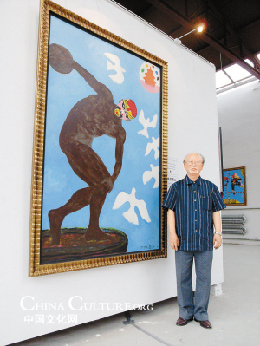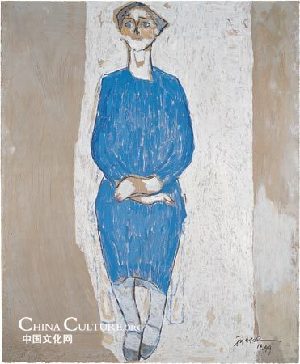Beijing's 798 art district, a cultural landmark which was once a secret military factory complex, has gotten a facelift for the Olympic Games. Located in the Jiuxianqiao area in Chaoyang district, the art district recently got Chinese-English road signs, professional foreign language guides, a tourist service center and an official website.
Gone are the days of no streetlights, no taxis, no parking lots and no public toilets. The district has finally been upgraded by the government to match its role as an art hub of some 400 galleries, design studios, exhibition spaces, shops and restaurants.

"Bird's Nest" by Wu Guanzhong
With its mottled red-brick walls, gigantic Bauhaus-style factory workshops and Mao-era slogans, the 798 art district surpasses even the Forbidden City as the most popular tourist destination with more than one and a half million visitors last year, according to the latest government report.
Abstract contemporary sculptures stand beside big rusty machinery, and fashion shows are held in the spacious former workshops. Every day dozens of exhibitions are launched and the district brings in revenues of 300 million yuan ($43 million) a year.

"Earth Fire" by Wu Guanzhong
Olympian artistry shines all In the middle of July, 2008, a series of Olympic-themed exhibitions, including “Silk-screen Printing exhibition to acclaim the Olympics" and Chen Jinfang's "Art for Humanity World Tour 2005-2010", were staged at 798, focusing the spotlight on the once unnoticed art factory.
Silk-screen printing or serigraphy, first appeared in its recognizable form in China during the Song Dynasty. It is a printmaking technique that uses a woven mesh to support an ink blocking stencil. The attached stencil forms open areas of mesh that transfer ink as a sharp-edged image onto a substrate. A roller or squeegee is moved across the screen stencil forcing or pumping ink past the threads of the woven mesh in the open areas. A screen print or serigraph is an image created using this technique.
 "Two beauties in the Qing Dynasty" by Wang Huaiqing
"Two beauties in the Qing Dynasty" by Wang Huaiqing
The serigraphy artworks on show managed to come up with a perfect combination of sports and art, such as Wu Guanzhong's “Earth Fire”, and his artistic depiction of the “Bird's Nest”, “Woman in blue” by Luo Erchun, “Wrestling” by Li Fuyuan, “Two Beauties in the Qing Dynasty” by Wang Huaiqing, and “Waterside Village” by Wang Yifu.
In "Art for Humanity World Tour 2005-2010" exhibition, Chen Jinfang presented several artworks featuring Olympic spirits, such as peace, tolerance and love.

Dr. Chen Jinfang and his artwork
In 2001, the Friends of the United Nations honored Dr. Chen with a Global Tolerance Award and designated him a "Cultural Ambassador for Tolerance and Peace", to honor his "art of multiculturalism and a lifetime of work dedicated to peace, tolerance and love and for creating a body of work expressing a shared vision of humanity." With their blessing, Dr. Chen initiated the “Art for Humanity World Tour” and this year has brought the Tour to China.

"Woman in blue" by Luo Erchun
During the Olympic Games, heads of 50 to 60 countries visited the district. The district's famous visitors have included United States Treasury Secretary Henry Paulson, former German Chancellor Gerhard Schroeder and French President Nicolas Sarkozy.